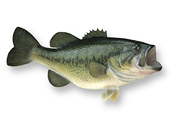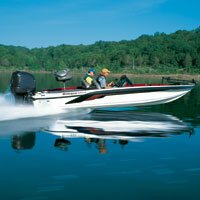Bass Fishing
For sport anglers, largemouth bass and smallmouth bass are two of the most prized catches. Bass spend most of their time in lakes and rivers with plentiful fresh water. They tend to congregate in mossy, sheltered areas to prey on smaller fish, such as minnows.
The best time to fish for bass is May through July, using minnows, crayfish, night crawlers, jigs, crank baits and spinner baits. Both live bait and artificial lures will attract bass, but one may be more attractive to smallmouth bass as opposed to largemouth bass. Early morning and late evening are the best time to catch bass as they tend to take shelter from the sun during the day. They are more active when the climate is cooler and the sun is not as bright.
Largemouth Bass
Micropterus salmoides
AKA: Black bass, green trout, bigmouth bass, lineside bass
This species is considered the most popular gamefish in the United States. Largemouth bass fishing tournaments have become very popular in recent years.
Distinguishing Markings:
Largemouth bass can be recognized by the lower jaw that extends past the back edge of the eye.
It is dark green above with silvery sides and belly and a dark stripe across its body. . The underside ranges in color from light green to almost white. They have a nearly divided dorsal fin with the anterior portion containing nine spines and the posterior portion containing 12 to 13 soft rays
Size:
Largemouth bass have been known to reach weights of over 20 pounds.
Distribution:
Find largemouth bass in the St. Lawrence, Great Lakes, Hudson Bay (Red River), and Mississippi River basins; Atlantic drainages from North Carolina to Florida and to northern Mexico. The species has been introduced widely as a game fish and is now cosmopolitan.
Habitat:
Largemouth bass are found in all waters from freshwater to brackish (a mix of fresh and saltwater) waters. They like large, slow moving rivers or streams with soft bottoms.
They especially like clear water. Immature largemouth bass may tend to congregate in schools, but adults are usually solitary. Sometimes several bass will gather in a very small area, but they do not interact. Largemouth bass seek protective cover such as logs, rock ledges, vegetation, and man-made structures. They prefer clear quiet water, but will survive quite well in a variety of habitats.
Food:
Greedy carnivores, largemouth bass feast on minnows, sunfish, gizzard shad, insects, frogs and occasionally snakes. Adult largemouth bass are the top predators in the aquatic ecosystem. Fry feed primarily on zooplankton and insect larvae. At about two inches in length they become active predators. Adults feed almost exclusively on other fish and large invertebrates such as crayfish. Larger fish prey upon smaller bass. Adult fish feed near water plants in shallow waters.
Spawning:
Largemouth bass spawn as early as March or as late as June. The males build saucer shaped nests 20 to 30 inches in diameter and guard the nest and eggs from all intruders. Largemouth bass grow 4 to 6 inches during their first year, 8 to 12 inches in two years, and up to 16 inches in three years. Largemouth bass may live for 13 years.
Bass Fishing Tips:
These fish are an extremely popular sport fish. They are excellent fighters when caught on light spinning tackle. Popular methods of fishing are fly-fishing, bait casting, or bottom fishing, and good baits include live minnows, night crawlers, and worms. For more information, read bass fishing tips written by professional bass fishermen.
Bass Boats
If you’re new to bass fishing, or a seasoned angler looking for a new bass boat, see our section on bass fishing boats.


